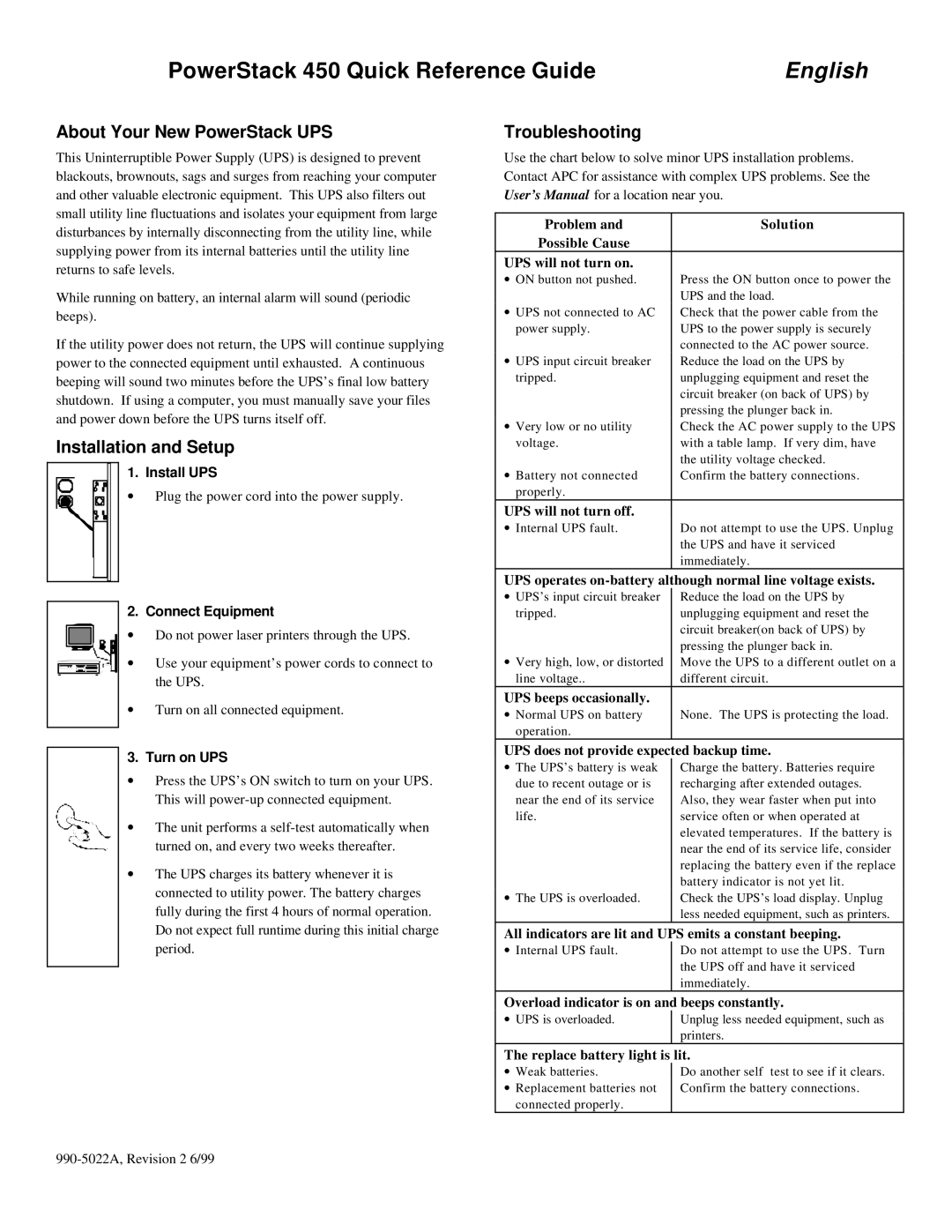
PowerStack 450 Quick Reference Guide | English |
About Your New PowerStack UPS
This Uninterruptible Power Supply (UPS) is designed to prevent blackouts, brownouts, sags and surges from reaching your computer and other valuable electronic equipment. This UPS also filters out small utility line fluctuations and isolates your equipment from large disturbances by internally disconnecting from the utility line, while supplying power from its internal batteries until the utility line returns to safe levels.
While running on battery, an internal alarm will sound (periodic beeps).
If the utility power does not return, the UPS will continue supplying power to the connected equipment until exhausted. A continuous beeping will sound two minutes before the UPS’s final low battery shutdown. If using a computer, you must manually save your files and power down before the UPS turns itself off.
Installation and Setup
1. Install UPS
∙ Plug the power cord into the power supply.
2. Connect Equipment | |
∙ Do not power laser printers through the UPS. | |
∙ | Use your equipment’s power cords to connect to |
| the UPS. |
∙ | Turn on all connected equipment. |
Troubleshooting
Use the chart below to solve minor UPS installation problems. Contact APC for assistance with complex UPS problems. See the User’s Manual for a location near you.
Problem and | Solution |
Possible Cause |
|
UPS will not turn on. |
|
∙ ON button not pushed. | Press the ON button once to power the |
| UPS and the load. |
∙ UPS not connected to AC | Check that the power cable from the |
power supply. | UPS to the power supply is securely |
| connected to the AC power source. |
∙ UPS input circuit breaker | Reduce the load on the UPS by |
tripped. | unplugging equipment and reset the |
| circuit breaker (on back of UPS) by |
| pressing the plunger back in. |
∙ Very low or no utility | Check the AC power supply to the UPS |
voltage. | with a table lamp. If very dim, have |
| the utility voltage checked. |
∙ Battery not connected | Confirm the battery connections. |
properly. |
|
UPS will not turn off. |
|
∙ Internal UPS fault. | Do not attempt to use the UPS. Unplug |
| the UPS and have it serviced |
| immediately. |
UPS operates | |
∙ UPS’s input circuit breaker | Reduce the load on the UPS by |
tripped. | unplugging equipment and reset the |
| circuit breaker(on back of UPS) by |
| pressing the plunger back in. |
∙ Very high, low, or distorted | Move the UPS to a different outlet on a |
line voltage.. | different circuit. |
UPS beeps occasionally. |
|
∙ Normal UPS on battery | None. The UPS is protecting the load. |
operation. |
|
UPS does not provide expected backup time. | |
I![]()
3. Turn on UPS
∙Press the UPS’s ON switch to turn on your UPS. This will
∙ The unit performs a
∙The UPS charges its battery whenever it is connected to utility power. The battery charges fully during the first 4 hours of normal operation. Do not expect full runtime during this initial charge period.
∙ The UPS’s battery is weak | Charge the battery. Batteries require |
due to recent outage or is | recharging after extended outages. |
near the end of its service | Also, they wear faster when put into |
life. | service often or when operated at |
| elevated temperatures. If the battery is |
| near the end of its service life, consider |
| replacing the battery even if the replace |
| battery indicator is not yet lit. |
∙ The UPS is overloaded. | Check the UPS’s load display. Unplug |
| less needed equipment, such as printers. |
All indicators are lit and UPS emits a constant beeping. | |
∙ Internal UPS fault. | Do not attempt to use the UPS. Turn |
| the UPS off and have it serviced |
| immediately. |
Overload indicator is on and beeps constantly. | |
∙ UPS is overloaded. | Unplug less needed equipment, such as |
| printers. |
The replace battery light is lit. | |
∙ Weak batteries. | Do another self test to see if it clears. |
∙ Replacement batteries not | Confirm the battery connections. |
connected properly. |
|
